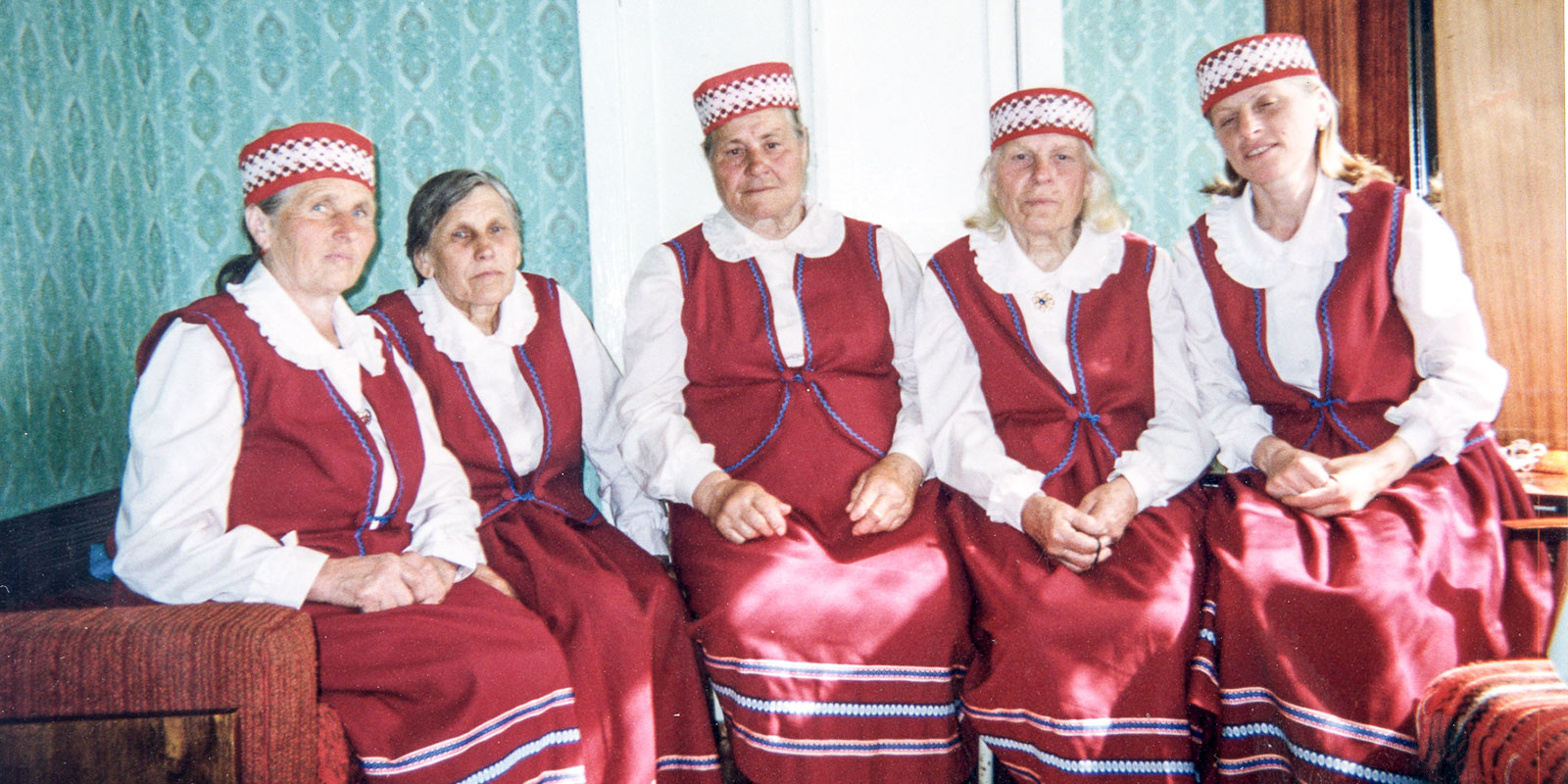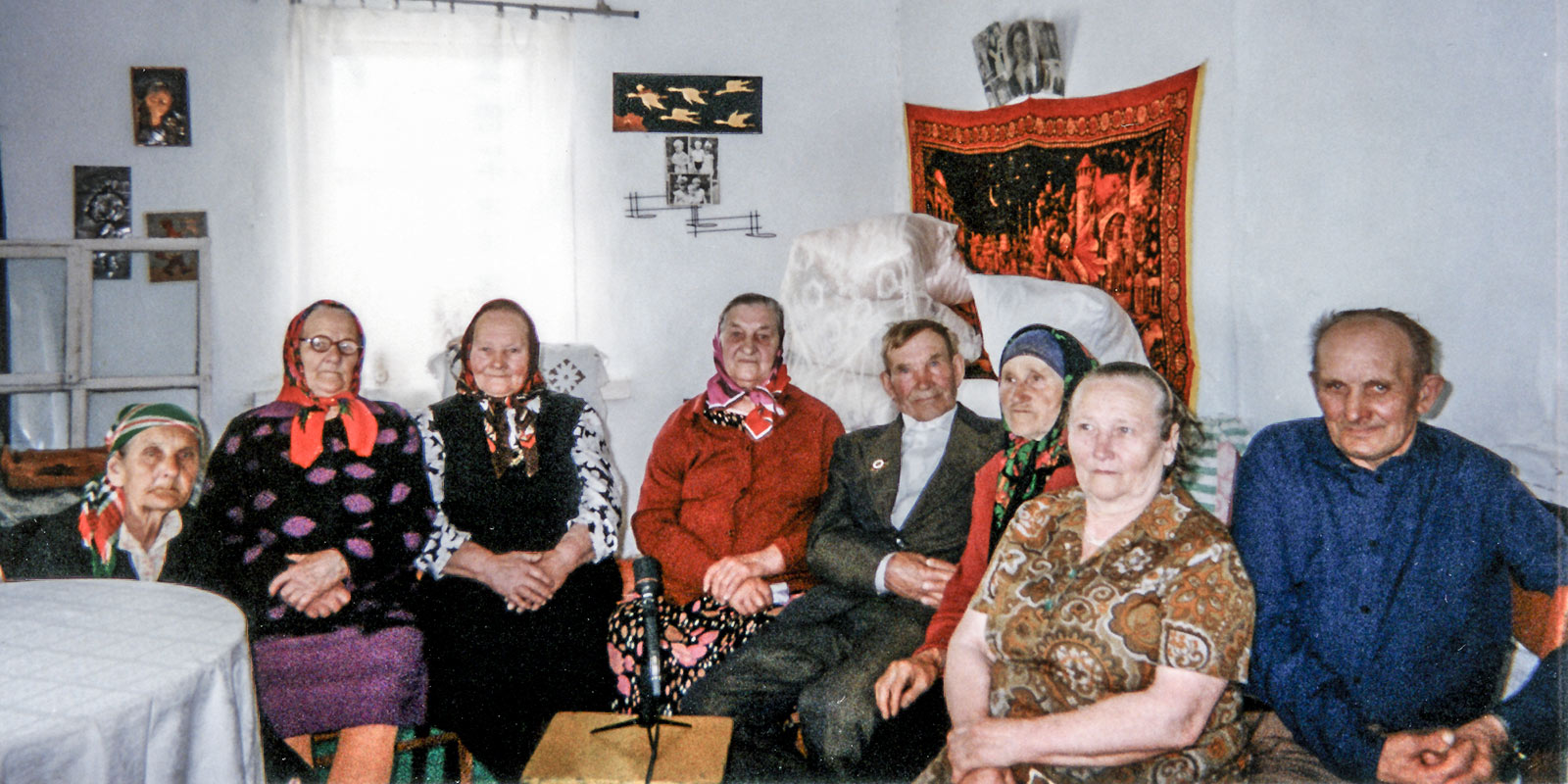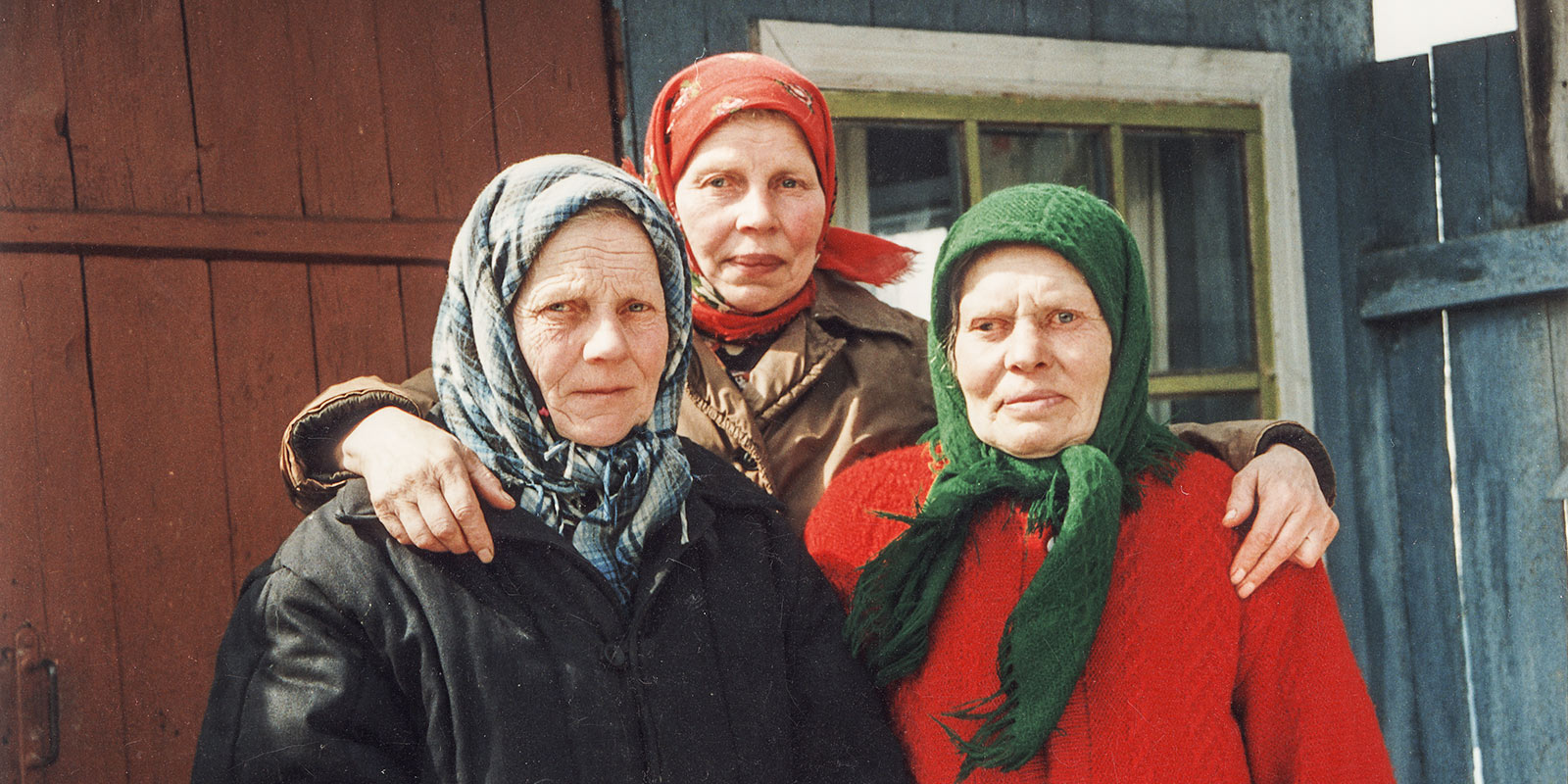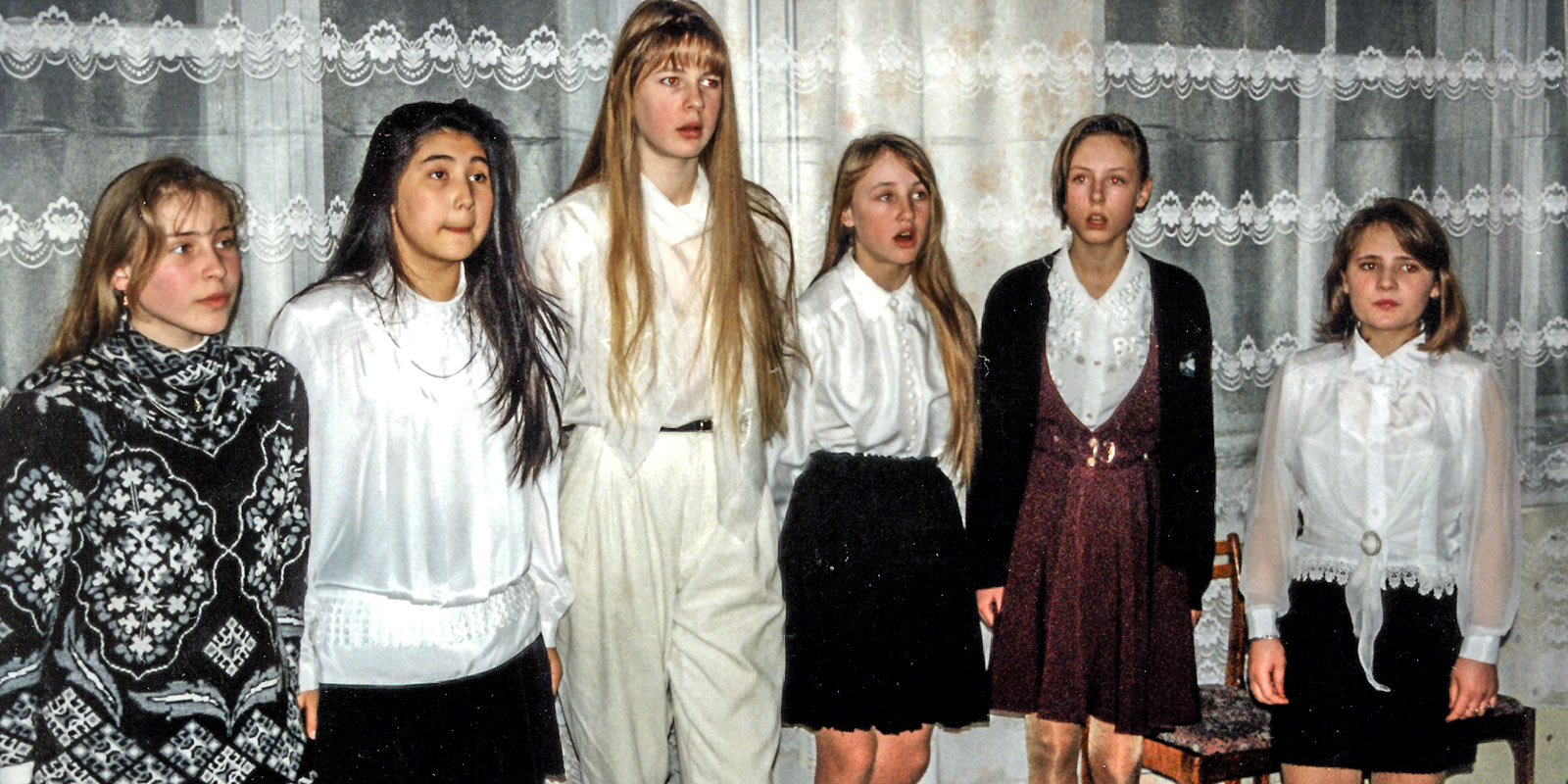The singing tradition
Recording situations
When we asked the local Estonians in Siberian villages to record their songs, the singers usually gathered at a villager’s house, and the singing was performed at a feast table in a relatively relaxed atmosphere. However, the presence of the researcher and of the recording equipment was never fully forgotten, as the singers kept checking if the goings-on were actually being recorded, kept trying to avoid songs with obscene content, etc. Sometimes, they would try to shorten a song when singing it to the collector, omitting verse repetitions, performing choruses of dance game songs after the last stanza only, leaving out whole stanzas in longer songs that might have been considered irrelevant or inappropriate. More often than not, the hosts did not invite all of the best singers, preferring those within their circle of friends. In some villages, the singing performance took place in community buildings instead (e.g., a club in Berezovka, a church in Verkhnii Suetuk). The solo singers who would not fit into a group or were confined to their homes, as well as those who had relocated to county centres or Russian villages, performed their songs alone. It is safe to say that we managed to record the bulk of all Estonian-language song repertoire surviving in the village communities; the only songs that the singers were less willing to share, but knew equally well, were those with obscene content and ritual death and funeral songs.
The song repertoire
The singers have learned most of the Estonian-language songs from their predecessors – their parents, grandparents, and fellow villagers. The tradition of Estonians in Siberia has much in common with that in homeland Estonia. Siberia’s Estonians mostly sing end-rhymed songs, as by the time of emigration and the formation of settlements, the transition to a new singing style that gained popularity in the second half of the 19th century had already taken place. In addition to end rhyme, this style is characterized by verses grouped into stanzas, song-like melody, and predominant individual tune. Previously, the Estonian areas had been dominated by alliterative Kalevala-metric folk song, the structure of which is common among all Baltic-Finnic peoples. Characteristic of the Siberian song tradition are romantic love songs – mostly narrative ballads of borrowed origin. Such songs have been popular also in Estonia, although they have survived longer in the Siberian tradition. Also, prison and war songs are solidly fixed in the repertoire and, as expected, these are best remembered in the villages founded by deportees. Drinking songs and jocular songs are quite popular as well. Rarely played today, dance games are best remembered among the Estonians of Berezovka, Verkhnii Suetuk, Kovalevo, Yuryevka, and Oravka. When singing dance game songs without playing them out, the singers often left out the dance part, even though they remembered it well. The different northern and southern Estonian traditions of dance game song and rhymed song have become largely even in the Siberian villages. Several songs that are generally found in the southern part of Estonia are in Siberia sung in villages that otherwise display typically northern dialectal peculiarities. In Estonia, the tradition of rhymed songs, including dance game songs, has survived longer and closer to the original form in the south. In Siberia, the villages where the northern dialect is spoken are by no means inferior to villages with emigrants from the southern regions of Estonia in their singing skills and the richness of their repertoire.
Almost all the Siberian villages had their own songsmiths, and the structure and content of the local village songs are quite similar to those in Estonia. In both the Estonian and the Siberian tradition one can find songs based of specific tragic events, belonging to either the local agrarian tradition or the sentimental German song layer (see af I 27).
In step with the surge in publishing Estonian-language literature in the mid-19th century emerged songbooks in Estonian language. The first printed songbook was published in Estonia in 1852 and soon after songbooks were being printed and circulated on a massive scale. Similarly to folk songs, the published songs (translated or adapted songs, transcripts of the oral tradition, original compositions by compilers of the books, etc.) began to spread from mouth to mouth, whereas the performers remained often unaware of the printed source. Printed songbooks were taken along by expatriates and were even later obtained from Estonia.
The spread of literacy among the general public set the stage for the proliferation of handwritten notebooks of songs – instead of memorizing their favourite songs, people often started to pen them down on paper. Songs or poems were written down in the notebooks by both the owner and his or her friends and acquaintances. The settlers may have taken some notebooks of songs and poems with them when they left Estonia, although it appears that the majority of such books were written in Siberia. Unfortunately, many printed and handwritten songbooks were destroyed in the years of repression. Today, however, the limited command of literary language among Siberian Estonians often prevents them from singing from other people’s songbooks.
By the time of emigration, the national awakening, related closely to singing and music, had already taken place in Estonia, and so the settlers went on to establish their own singing societies and choirs in Siberia, engaging mainly in polyphonic choir singing in the German fashion, just like in their native country. In the summer of 1924, the song festival of Estonians in the Mariinsky district was held in Vambaly village. Before the separation of church and school, religious as well as secular songs were taught in Estonian schools in Siberia. During recess, on the other hand, children preferred to play dance games, game and dance songs which were part of their ethnic tradition, which was not looked kindly upon by some teachers, who regarded such “street songs” unfit for schoolchildren.
People living in nearby Estonian communities (e.g., Estonka and Lileyka) always maintained close relations; often, even the distance of hundreds of kilometres (e.g., between Oravka and Nikolayevka) did not prevent them from socializing. The learning of each other’s songs was facilitated by mutual visits and common party evenings, as well as marrying into or moving to another Estonian community at one’s relatives’ invitation. On the other hand, village communities adamantly held on to their own traditional versions of songs, and were often reluctant to accept the way the songs were sung in another community.
During and after World War II, the Siberians’ song repertoire was substantially supplemented with new songs from Estonia – Siberia’s Estonians served in the Estonian Rifle Corps, and brought back with them songs that they heard from their comrades in arms. Also, Estonians from homeland, who had been evacuated or wounded in battle and sent to recuperate in Siberia, were another source for new songs. In the postwar years, the ties between Estonians in Siberia and in homeland grew closer: there were reciprocal visits and mass repatriation from some settlements. Some repatriates failed to adjust to the life in Estonia, or the climate, and ended up returning to Siberia. The songs learned from homeland Estonians are often referred to as songs of Estonia. Also, numerous Estonian songbooks, vinyl records and audio cassettes from Soviet times have made their way to Estonians in Siberia.
Russian songs became more popular among Siberia’s Estonians after World War II, when the number of non-Estonians in their villages started to increase. These songs were also learned from records and cassette tapes, as well as from radio broadcasts, and became particularly popular among the younger generation of Estonians, who have been educated in Russian. Quite expectedly, the share of songs translated from Russian is also greater in Siberia than in homeland Estonia. In addition, the Estonians in mixed-Lutheran settlements (e.g., Ryzhkovo, Kovalevo, and Verkhnii Suetuk) knew, to some extent, songs borrowed from their other neighbours, especially from Latvians and the Finnish. Today, these songs are best known in the Ryzhkovo village.
The tunes*
The repertoire of Siberian Estonians is dominated by tunes in the major-minor key system, typical of the newer Estonian folk song, and sung (or attempted) in two voices – mainly in parallel thirds, sometimes using the harmonious bass of the tonic and the dominant. Particularly vivid examples of this style are the tunes in major keys with a cadence on the third note of the tonic chord (see af I 20, 28; af II 1, 3, 5, 17).
Apart from this kind of songs, there are others – such as the newer folk songs which are popular throughout Russia (see af I 18; af II 19, 23). The lyrics of the first two songs have also been translated from corresponding Russian songs. Among the songs on the disks, we also find a Lutheran chorale (af II 22), a song by the Russian composer Aleksandr Dargomyzhski (1813–1869) (af II 14), an adaptation of a Ukrainian folk song (af II 30), and a Mexican melody popular both in Estonia and in Russia. In Estonia, the latter was tranformed into a beer song with the chorus: “Drink, friend, drink” (af II 34).
In terms of musical style, the songs from Ryzhkovo are an intriguing exception. Their tunes and polyphonies reveal close relation with a somewhat earlier Russian lyrical repertoire. Indeed, a couple of the songs may well have been built upon Russian tunes (e.g., af I 15, 16), combined (in the case of the last song, rather contrivingly) with Estonian lyrics. A higher degree of musical “Russification” among the Ryzhkovo singers is suggested by the fact that in almost all the songs they try to employ a special kind of polyphony, which in Russia is idiomatically called пение с подводкой. A characteristic feature of the style are specific cadences ending in an octave (the best example being af I 15).
Russian influences can also be traced in the performance style of singers from some villages. When comparing the singing styles of the women from Kovalevo and Berezovka (in both villages multi-part singing has been preserved relatively well), it appears that the former sound more Russian: they sing with more resonant chest voices, slower, and in an intensively emotional manner. The latter perform similar songs with reticence characteristic of Estonians, with softer and higher voices.
* The overview of the tunes sung by Estonians in Siberia was written by Žanna Pärtlas in 2005.
Performance situations
Folk holidays and festivities are usually considered as the traditional performance occasions for end-rhymed songs. Such songs were also sung during working, and especially while on one’s way to and from work (e.g., going to and returning from the forest, the field, etc.). There are plenty of reports about that from Estonians in Siberia.
In the youth of those knowledgeable in Estonian songs, singing was considerably more popular than it is today. Singing was an integral part of all village festivities. The more frequent youth get-togethers – called ball, säru, or kirmas – took place on Thursday, Saturday, and Sunday evenings; in summer, young people might gather to sing and dance even more often than that. During summertime, any scenic place would do for the venue of such get-togethers; there were also special gardens created for this purpose. One could also sing and dance on village streets, and it was not unusual that people sang while sitting on the benches behind a gate. From Russians, the Estonians in Siberia picked up the tradition of singing while walking along the village streets, known as guljaitamine (from Russian гулять ‘walk’, ‘stroll’). In wintertime, the gatherings would take place at the slightly larger house of some kind family; later, community centres or clubs were established in most villages. The Socialist-era red-letter days (e.g. International Women’s Day, May Day, and October Revolution Day) the village folk also celebrated together.
Joint singing was practiced also at girls’ handicraft evenings; the custom was called õhtat istma, istele käima, ilta istma, or from Russian, sidelka – all of them references to “sitting, passing the evening”.
Naturally, singing was also part of home parties and family celebrations. Rather grand farewell parties thrown for young army recruits were quite common even recently, with war and soldier songs making up the repertoire for the evening. The predominantly mixed marriages of today have largely superseded the Estonian wedding tradition, including wedding songs. On the other hand, birthday celebrations have become increasingly popular. Yet the birthday wake-up songs, sung even 10 to 20 years ago by the entire village, are now sung only within the family circle. The tradition of singing at wakes and funerals has survived to greater extent. Even in the villages where other forms of singing have been abandoned, the people still sing at funerals. The repertoire of death songs and the ratio of secular to religious songs depended mainly on the taste and skills of the local village burier. Estonians also used to sing funeral songs and hymns in the graveyard on Sundays and holidays (St. John’s Day, Whitsunday). The celebration of vernal and autumnal folk calendar holidays involved dancing and singing on village streets or in a grove near the village. In addition, singing on the streets has sometimes been practised on some autumn and winter folk calendar feast days (e.g. Easter, St. Martin’s Day, St. Catherine’s Day).
In the postwar period, folklore ensembles were established in many former Estonian villages; in a sense, these may be considered a continuation of the former community life. Songs, both Russian and Estonian, were now learned specifically for performing purposes. Performances were given at local parties and in adjacent Russian and other villages, as well as at special folklore festivals that introduced a competitive element. Often the performers even procured similar outfits for the occasion. By now, some of the singers have passed away and most Estonian folk music groups in Siberia have ceased their activities.




